
| Abiqua Dogs |
| Abiqua Pumi |
| About Pumis |
| Our Dogs |
| Our Home |
| Grooming |
| Pumi Standard |
| Getting a Puppy |
| Puppies |
| Links |
Now available on YouTube!
Grooming a Pumi Video Click here to see it. |
|
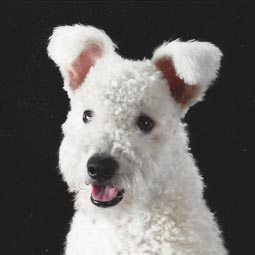 I
have been breeding and
showing dogs for almost 40 years, but have had Pumis only since 1999.
I am an expert in grooming Miniature Schnauzers, but when faced with a
hairy Pumi, had no idea what to do with him. I hope this helps those who are
new to the breed and desperate for more information on the Pumi that is
written in English. Many thanks to Tamara Langer for the
illustrations.
I
have been breeding and
showing dogs for almost 40 years, but have had Pumis only since 1999.
I am an expert in grooming Miniature Schnauzers, but when faced with a
hairy Pumi, had no idea what to do with him. I hope this helps those who are
new to the breed and desperate for more information on the Pumi that is
written in English. Many thanks to Tamara Langer for the
illustrations.
The ideal Pumi coat is elegant, neither too long nor too short,
suitably thick, curly, and it is made up of very nice "locks of
hair". The coat can be maintained quite easily by combing (not
brushing) the coat every week or two. After being combed, the Pumi must
be bathed or "wetted down" and left to dry on its own. Never
brush and blow dry the hair which takes away the curly
locks of hair that is a Pumi characteristic. You may use a hair dryer,
but do not brush at the same time, and blow gently.
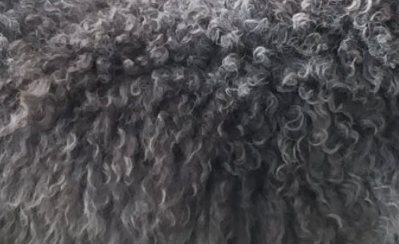 Pumi breeder Tamara Langer
described the best way to see what the Pumi hair should look like is to
take your dog swimming for five days in a row and each time let him dry
naturally. Then his hair will take on the correct characteristics. The Pumi does not shed, but must be trimmed and/or plucked every 2-4
months to keep him looking tidy. The correct look of the Pumi should govern how he is trimmed, so
let's take a brief look at the standard of perfection for the
Pumi. The Pumi is a square dog - he should be the same length from his
withers to the ground as he is from the forechest to the buttocks. The
sides of the body are rather flat (not rounded or barrel-shaped). The
withers are clearly noticeable, the back line slopes slightly. He has a
high-set tail curled over the back, a relatively narrow, wedge-shaped
head with very little stop, and high-set, semi-erect ears, with about
1/3 of them folding over. His legs should be straight when viewed from
the front or rear, with moderately angulated shoulders and rear.
OK, now how does that translate to grooming?
Pumi breeder Tamara Langer
described the best way to see what the Pumi hair should look like is to
take your dog swimming for five days in a row and each time let him dry
naturally. Then his hair will take on the correct characteristics. The Pumi does not shed, but must be trimmed and/or plucked every 2-4
months to keep him looking tidy. The correct look of the Pumi should govern how he is trimmed, so
let's take a brief look at the standard of perfection for the
Pumi. The Pumi is a square dog - he should be the same length from his
withers to the ground as he is from the forechest to the buttocks. The
sides of the body are rather flat (not rounded or barrel-shaped). The
withers are clearly noticeable, the back line slopes slightly. He has a
high-set tail curled over the back, a relatively narrow, wedge-shaped
head with very little stop, and high-set, semi-erect ears, with about
1/3 of them folding over. His legs should be straight when viewed from
the front or rear, with moderately angulated shoulders and rear.
OK, now how does that translate to grooming?
The order of grooming is
Grooming Tools This
is a great brush we discovered recently. Properly used, it will
take out most of the tangled hair (not hard-set mats) and make it easier
to run the comb through the hair. Use this before combing, but not
as a substitute for a good combing. Hold the hair and comb bits of
the hair away from what you're holding, so that the hair becomes
untangled a bit at a time. You can order it at
https://www.showdogstore.com/chris-christensen-original-series-t-brush/.
Choose the 16mm Mini.
This is a comb that looks like a rake, but works great to comb the hair
which should be done at a minimum of every 3 weeks (more often from 6-12
months old when they haven't gotten their coarser, adult coat). You will
get hair out when you comb, but then your puppy won't be leaving hair
lying around the house at other times. You can get the comb at this web
site:
https://www.amazon.com/gp/product/B073ZK287B/ref=ppx_yo_dt_b_asin_title_o00_s00?ie=UTF8&psc=1&pldnSite=1.
You can use any good dog shampoo,
but not human as a dog's pH is different than human. You shouldn't bathe
them more than once a month unless they're getting really dirty. The nice
thing about a Pumi's coat is that they can get dirty and the dirt doesn't
seem to stay in the coat. If you're going to do the scissoring work
yourself, you will also need to pull any hairs out of the ear canal that
grow there. You can use these hemostats to do that more easily than
tweezers. You can get them at this link:
http://www.showdogstore.com/miller-forge---hair-puller-locking.aspx.
Get the 5" straight ones. You will also need scissors to do the
touchup work and you can use any good hair scissors that are at least
8" long. All
but the comb can be obtained through
www.showdogstore.com,
so you only have to pay shipping once.

The dark areas on the diagram
illustrate where the coat is at its shortest (about 1-3 cm or 1/2 -
1-1/4 inches ), the white
areas represent those areas where the coat is at its longest (7 cm,
2-3/4 inches maximum), in the gray areas the coat is somewhere in between.
The length of coat is measured when the coat is curled up, so the actual
length of the hairs is longer than these measurements. The final length of
the coat depends on the structure of the Pumi: the coat of a
strong-bodied Pumi should be kept shorter, while a light-bodied Pumi can
have longer hair, etc. There shouldn’t be any clear edges in the
coat - everything should be rounded. The front (forechest) and back (buttocks) of the Pumi are trimmed
shorter to preserve the correct, square look. Be careful with the
backline so that it doesn’t look arched, sway-backed or slant the
wrong direction.

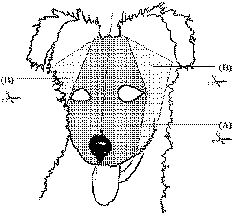
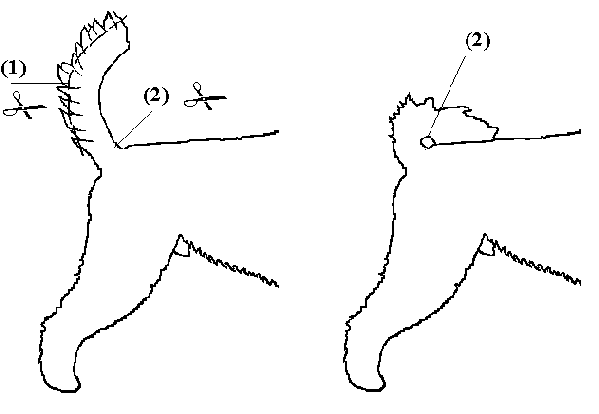

Before a Dog Show
Tamara Langer: "We usually don't pull the hair before showing, or we do it only very carefully. Otherwise I usually prepare the coat
of my dogs one or two weeks before the show and then I let it take up a
natural form. That's also the time when I bathe them with shampoo. The
day before the show I just bathe them with clear tap water under the
shower and let them dry."
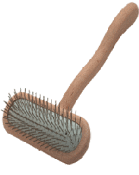
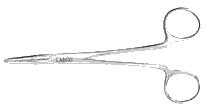
Copyright © 2000 All Rights Reserved
Last updated: 01/31/23